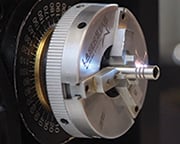Precision Laser Processing: How Motion Control Systems Enhance Laser Welding and Marking
Laser technology is now widely used in manufacturing and has become a preferred method of marking or engraving parts as well as welding them together into specific assemblies. Both processes use direct laser beams delivered in short pulses that cover a specific area, whether it’s to ablate or anneal the material for engraving purposes, or to deep-weld sections to create a hermetic seal. Whatever the purpose for which you’re using it, motion control systems for laser processing is vital to ensure precision of the process.
Motion Control Devices
Motion control devices come in a variety of different types, which are either linear or rotary controllers. Both types are designed to guide a laser beam in the trajectory you want it to follow. Many applications using laser marking and laser welding make use of microscopic parts, which are impossible to work on without the use of sophisticated technology. Motion control for laser systems guide the beam of light to produce the results that are programmed into the motion control software. This makes it possible to operate the laser accurately and achieve the necessary number of repetitions needed for a consistent pattern or a reliable seal.
Laser Applications Using Motion Control
Laser marking: Non-contact laser marking is used on metal in the same way as traditional engraving for purposes such as laser engraving designer patterns or identifying marks on expensive jewelry, or imprinting medical devices such as hypodermic needles, catheters and insulin pumps with critical information for their operation. All of the processes require absolute precision, which is controlled by a software program that drives the laser marking system to create the marks programmed into the system. Whether these are unique markings based on codes or lettering with character heights of around 10 µm, a motion control device is necessary to transfer the design from the program to the laser.
Laser welding: A number of medical devices need hermetically sound joints that are impervious to water or other liquids, air or gas. Many of these devices are implanted in the human body and the joints need to withstand bodily fluids and be strong enough to support the weight of a body part. The welding needs to be smooth enough to prevent thickening of the metal in critical areas, allow electrical conductivity in micro implants and often remain flexible, such as catheter tubing.
Linear Motion Controllers
Linear motion control for laser systems use an actuator motor that translates the pattern or markings designed using the software into motion which drives the laser beam. This is done by the transmission of signals that guide the laser along the lines defined in the pattern. Linear controllers are used for relatively simple, two-dimensional patterns or welds, such as basic joints of a small number of parts or the creation of marks with standard repetition and depth. Precision software enables the system to select the correct location for the laser marking, as well as to produce unique markings based on codes input using the application. As marks are generated, they are updated in a database in both data matrix code and readable text.
Rotary Motion Controllers
Rotary motion control for laser systems are used for more complex laser engraving or laser welding tasks, where the pattern followed by the laser beam is done in several stages. The signals are transferred from the software to the laser by means of a complete, 360 degree rotation of the controller as it completes a full cycle to close the loop. This is useful when engraving designs in multiple sections of a piece. Rotary motion controllers often make use of servomotors to deliver the signals to the laser beam, and are able to operate at various speeds and with several different payloads.
Both linear and rotary motion controllers are available as stand-alone box controllers or as a card-level controller that can interface to a computer through an Ethernet or USB connection. If your manufacturing processes use either laser marking or laser welding, the addition of motion control is a step that will improve the accuracy and speed of your production while reducing the quantity of waste from damaged parts.
To learn more about laser technology, please contact LaserStar Technologies today.
{{cta(‘dde06b6f-e28e-4a56-92c5-e829f68de19a’)}}






